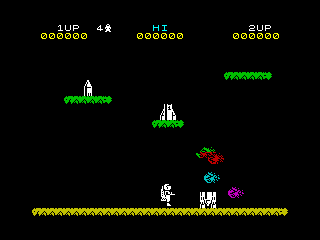ZX Spectrum
Being born in the UK in 1981, my articles about home computers are biased towards that time and place. This is due to both my own personal experience, and also a conscious attempt to provide an alternative UK bias to the predominant US bias amongst people my age reminiscing about home computers.
ZX Spectrum tech specs

Jetpac on the ZX Spectrum
ZX Spectrum palette
- Released: 1982
- Initial price: £125 (16 KB) or £175 (48 KB)
- Company: Sinclair
- Type: Home computer
- CPU: NEC µPD780C, later Zylog Z80A, @ 3.5 MHz
- RAM: 16 KB or 48 KB
- Storage: Cassette tape (bring your own tape recorder), Microdrive (optional)
- Display: 32×24 character / 256×192 pixel / 15 colour via CRT TV set
The ZX Spectrum was a home computer released by Sinclair in 1982. It was the phenomenally successful successor to the ZX81.
As was typical for Sinclair, it aimed for the low end of the market. You'd need to bring your own TV set and tape recorder to use it (the C64 and later CPC 464 only needed the TV set, providing their own tape recorder), the graphics were primitive, the sound was confined to a single channel of 1-bit beeping via an internal speaker, and joysticks required a third-party add-on. This all allowed it to be fantastically affordable. It was very likely the most popular home computer in the UK,[1] beloved in spite of its many shortcomings, and instilling a patriotic sense of pride in many a user.
As it worked with any tape recorder, it wasn't possible to implement anti-piracy measures. Many games were swapped via bootleg tapes in playgrounds across the country.
Each of its 8×8 pixel character blocks could have an independent choice of background and foreground colour. This was fine for text, but without any sprites to lay over the top of that single background layer, ambitious games tended to feature colour clashing: with only two colours per block, any part of an image appearing in more than a single block had to change colour to match its surroundings. Along with its garish colour scheme based more on maths than aesthetics, this gave the Spectrum a very distinctive art style.
A quirk of the ZX80 and ZX81 had accidentally introduced the concept of the loading screen. For the Spectrum, Sinclair's engineers took this side effect and turned it into a purposeful feature, adding colourful raster bars to the border while software loaded. Rivals like the C64 didn't do this in the firmware itself, leaving programmers on those platforms to implement their own loading screens, featuring raster bars of various different colour schemes.
As with all good 8-bit home computers, it instantly booted up straight into a BASIC interpreter, to better encourage the user's creativity.
The ZX Spectrum ushered in the home computer era of programming and playing computer games in the UK. It wasn't long before it had its own magazines, including Crash, the first computer game magazine in the country. Only the C64 (complete with rival magazine Zzap!64 from the same publisher) came close to rivaling its popularity.
I'd argue that, at least in the UK, the ZX Spectrum was a more influential symbol of 1980s pop culture than the Rubik's Cube or Pac-Man. Not only did millions of children and young adults while away countless hours playing its games, but a good few forged careers making those games.
Accessories
Beta Disk Interface
The Beta Disk Interface (and corresponding TR-DOS) by Technology Research gave the Spectrum a Shugart compatible 3.5″ floppy disk drive port.[2] It was relatively obscure.
Clones
Main article: Soviet ZX Spectrum clones.
The Spectrum was officially cloned by Timex in the US and Portugal, and Deci Bells in India. Unofficially, it was also cloned in many other countries, including Russia,[3] Romania, Czechoslovakia, Brazil, Argentina, and even the UK.
It's safe to say that Clive Sinclair achieved his goal of creating an affordable computer for the masses. Not only did Soviet factories with limited resources clone it, they often improved it.
References
- The Story of U.S. Gold: A Very American British Software House Chris Wilkins, Roger M. Kean, 2015, ISBN 9-780993-131530, pp. 56—57
- "Beta Disk TR-DOS V4 Interface" Crash, Nov 1985, pp. 116—117
- "People I've asked confirm [that the] ZX Spectrum was more widespread than all the Soviet home and school computers taken together..." "The Ultimate Total Number of ZX Spectrum Computers Produced" Alone Coder, Spectrum Computing, Aug 2021
Further reading
Reviews
- "Benchtest: Sinclair ZX Spectrum" David Tebbutt, Personal Computer World, Jun 1982, pp. 118—124
Home computers: Amiga | Beige box | Commodore 64 | PICO-8 | Plus/4 | ST | Soviet ZX Spectrum clones | ZX Spectrum | ZX Spectrum 128
Sinclair: Soviet ZX Spectrum clones | ZX Spectrum | ZX Spectrum 128
ZX Spectrum: Music Machine | Soviet ZX Spectrum clones | ZX Spectrum 128


